Jog Raj*, Hunor Farkaš, Svetlana Ćujić, Goran Grubješić, Jovana Dubajić, Zdenka Jakovčević, and Marko Vasiljević
PATENT CO, DOO., Vlade Ćetković 1A, 24 211, Mišićevo, Serbia
*Corresponding author: [email protected]
Corn is one of the most important cereal crops grown globally and it is essential for human and animal nutrition.
 However, its importance in the food and feed sectors is accompanied by concerns over contamination by mycotoxins—toxic secondary metabolites produced by certain species of fungi.
However, its importance in the food and feed sectors is accompanied by concerns over contamination by mycotoxins—toxic secondary metabolites produced by certain species of fungi.
These toxins pose a serious threat to food and feed safety due to their potential health impacts, which include teratogenic, nephrotoxic, hepatotoxic, neurotoxic, mutagenic, and immunosuppressive effects.
In recent decades, mycotoxin contamination in feed and food chains has received increasing attention due to the introduction of new legislative limits and advances in analytical techniques.
Therefore, the aim of this study was to quantify mycotoxins, using a multi-mycotoxin method based on LC-MS/MS triple quadrupole (Agilent 6460 series), in corn samples received from different regions of:
- ⇰ Algeria
- ⇰ Argentina
- ⇰ Austria
- ⇰ Brazil
- ⇰ Colombia
- ⇰ Costa Rica
- ⇰ Ecuador
- ⇰ Greece
- ⇰ Guatemala
- ⇰ Italy
- ⇰ Mexico
- ⇰ Peru
- ⇰ Polonia
- ⇰ Serbia
- ⇰ South Africa
- ⇰ South Korea
- ⇰ Thailand
- ⇰ USA

FROM FIELD TO DATA: SAMPLE PREPARATION AND MYCOTOXIN ANALYSIS
Corn samples were delivered to the PATENT CO. laboratory between September 2024 and February 2025. These samples were finely ground and homogenized using a laboratory mill.
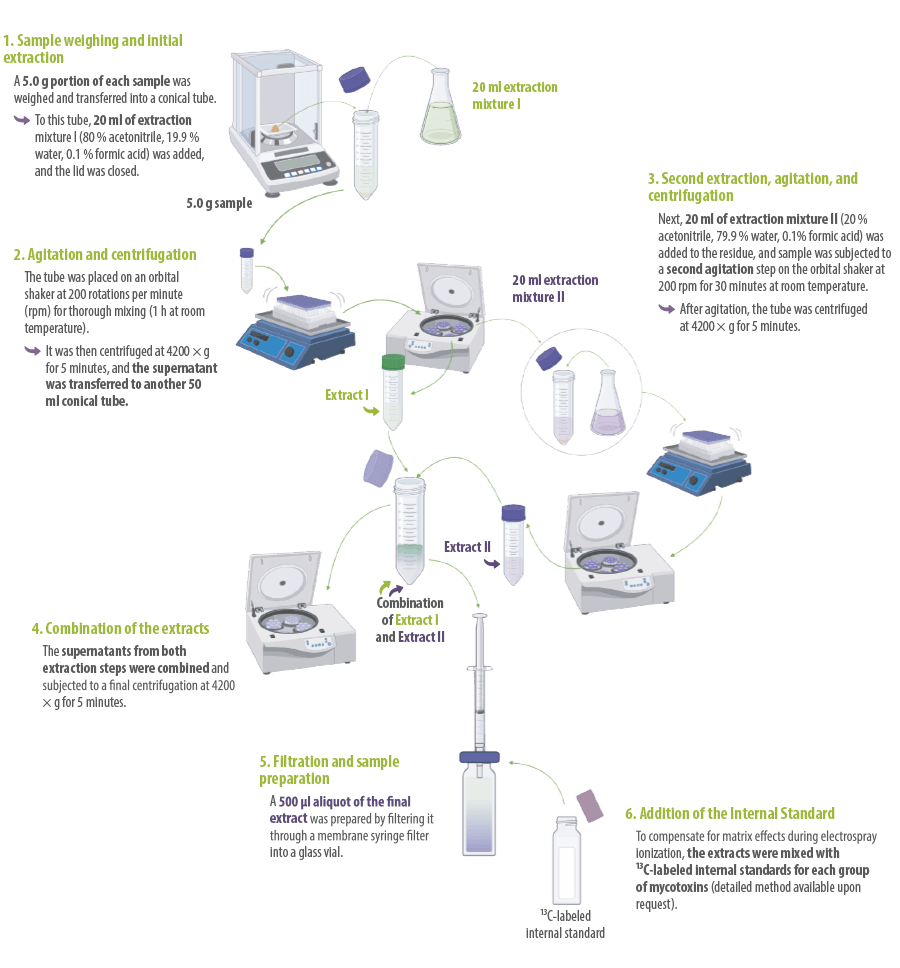
Corn samples from 18 countries were analyzed using LC-MS/MS for the following mycotoxins:
European Union (EU)-regulated mycotoxins:
 Aflatoxins (AFB1, AFB2, AFG1, AFG2)
Aflatoxins (AFB1, AFB2, AFG1, AFG2) Deoxynivalenol (DON)
Deoxynivalenol (DON) Fumonisins (FB1, FB2, FB3)
Fumonisins (FB1, FB2, FB3) HT-2 toxin
HT-2 toxin Ochratoxin A (OTA)
Ochratoxin A (OTA) T-2 toxin
T-2 toxin Zearalenone (ZEN)
Zearalenone (ZEN)
Emerging mycotoxins:
 Beauvericin (BEA)
Beauvericin (BEA) Enniatins (ENNA, ENNA1, ENNB, ENNB1)
Enniatins (ENNA, ENNA1, ENNB, ENNB1) Fusaric acid (FA)
Fusaric acid (FA) Moniliformin (MON)
Moniliformin (MON)
Other mycotoxins
 15-acetyl deoxynivalenol (15-ADON)
15-acetyl deoxynivalenol (15-ADON) 3-acetyl deoxynivalenol (3-ADON)
3-acetyl deoxynivalenol (3-ADON) Deoxynivalenol-3-glucoside (D-3-G)
Deoxynivalenol-3-glucoside (D-3-G) Diacetoxyscirpenol (DAS)
Diacetoxyscirpenol (DAS) Neosolaniol (NEO)
Neosolaniol (NEO) Nivalenol (NIV)
Nivalenol (NIV) Zearalanone (ZAN)
Zearalanone (ZAN) α-zearalenol (α-ZEL)
α-zearalenol (α-ZEL) β-zearalenol (β-ZEL)
β-zearalenol (β-ZEL)
The mycotoxin results were expressed in μg/kg (parts per billion, ppb), relative to a feed moisture content of 12 %.

GEOGRAPHICAL DISTRIBUTION OF MYCOTOXINS IN 2024-HARVESTED CORN
Country-wise data on average, maximum, minimum, median, and number of detected mycotoxins (%) per corn sample are presented as follows:
ALGERIA 
In corn harvested in 2024, 100 % of the samples were contaminated with one or more mycotoxins.
⇰ Among these, 2 % of the samples contained 1 type of mycotoxin, 22 % had 2 types, 29 % contained 3, and 47 % were contaminated with more than 3 types of mycotoxins (Figure 1).
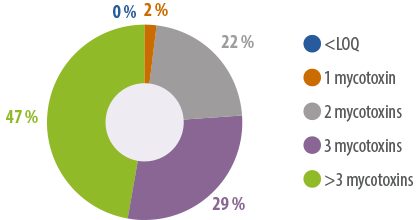
Figure 1. Number of mycotoxins detected in the 2024-harvested corn in Algeria.
The data in Table 1 show that DON was detected (average 341.6 ppb) in 14 % of the samples, FB1 (average 702.2 ppb) in 100 %, FB2 in 94 %, and FB3 in 67 % of samples.
Among emerging mycotoxins, BEA was detected in 8 % of the samples, while FA appeared in 37 %, and MON in 12 % of the samples, as determined by LC-MS/MS.

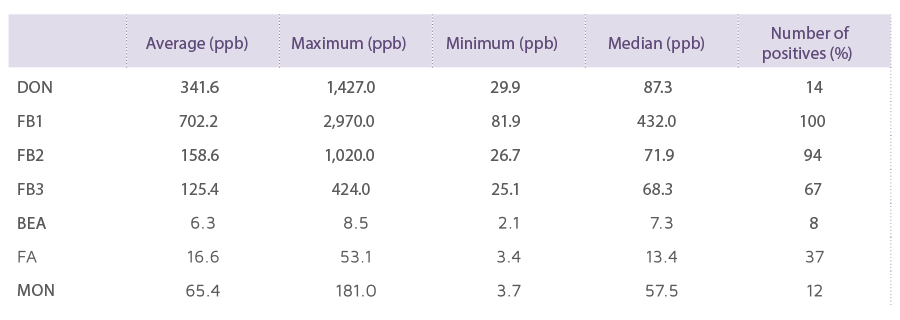
Table 1. Mycotoxin contamination levels (ppb) in corn samples from Algeria in 2024.

ARGENTINA 
Corn samples from Argentina were analyzed using LC-MS/MS and the data in Figure 2 reveal that 98 % of the samples were contaminated with one or more types of mycotoxins, while 2 % of samples were free of any mycotoxins.
⇰ Among the positive samples, 11 % contained 1 type of mycotoxin, 11 % contained 2 types, 9 % contained 3, and 67 % were contaminated with more than 3 mycotoxins per sample.
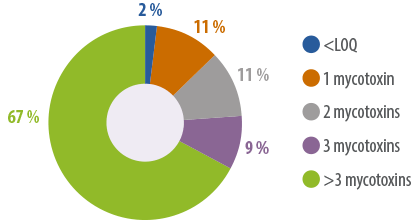
Figure 2. Number of mycotoxins detected in the 2024-harvested corn in Argentina.
Among EU-regulated mycotoxins, AFB1 was detected in 2 % of the samples, DON (average 226.1 ppb) in 50 %, FB1 (average 1183.7 ppb) in 62 % of the samples, FB2 in 59 %, FB3 in 53 %, and ZEN in 8% of the tested samples (Table 2).
BEA was found in 47 % of the samples, FA (average 51.6 ppb) in 86 %, ENNB in 14 %, and MON in 40 % of the samples.
Among other mycotoxins, only 15-ADON was detected, occurring in 17 % of the samples.
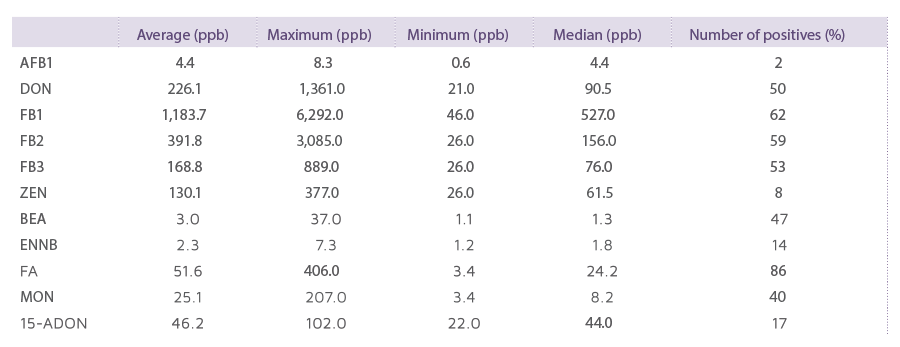
Table 2. Mycotoxin contamination levels (ppb) in corn samples from Argentina in 2024.
AUSTRIA 
All the tested corn samples from different regions of Austria in 2024 were contaminated with more than 3 types of mycotoxins.
The data in Table 3 demonstrate that AFB1 was found in 18 % of the samples, while DON (average 399.5 ppb) and HT-2 toxin were detected in 100 % of the samples. FB1 (average 238.9 ppb) was detected in 71 %, FB2 in 41 %, and FB3 in 24 % of the samples. T-2 toxin and ZEN appeared in 94 % and 35 % of the samples, respectively.
BEA (average 164.7 ppb), ENNB, and MON were found in 100 % of the samples. FA (average 90.2 ppb) was present in 71 % of the samples, and ENNB1 was detected in 53 %.
Additionally, 15-ADON was found in 29 %, and 3-ADON in only 12 % of the samples.
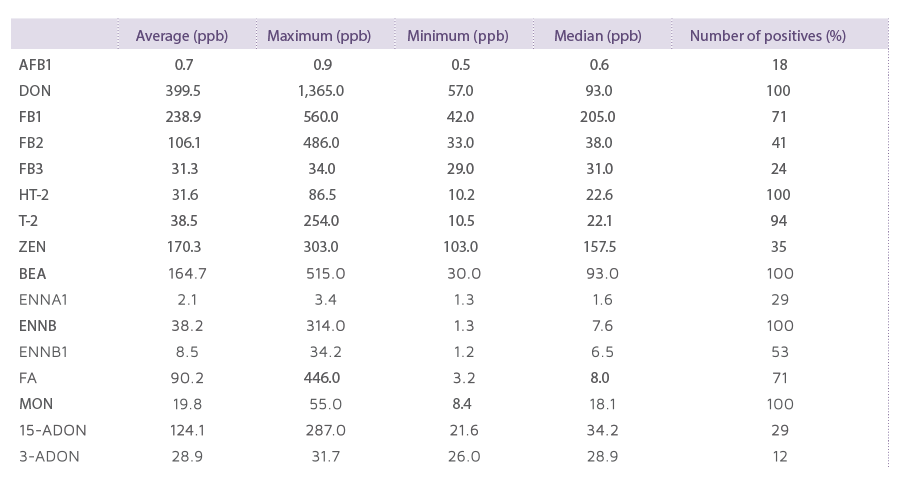
Table 3. Mycotoxin contamination levels (ppb) in corn samples from Austria in 2024.

BRAZIL
In 2024, 100 % of the corn samples from Brazil were contaminated with more than one type of mycotoxin. Occurrence of 3 types of mycotoxins per sample was the most common one.
AFB1 (average 25.7 ppb) appeared in 20 % of the samples, AFB2 in 16 %, DON in 32 %, FB1 (average 737.8 ppb) in 100 %, FB2 in 96 %, and FB3 was detected in 80 % of the tested samples using LC-MS/MS (Table 4).
Among emerging mycotoxins, BEA was present in 88 %, FA in 88 % of the samples, and MON was found in 40 % of the samples.

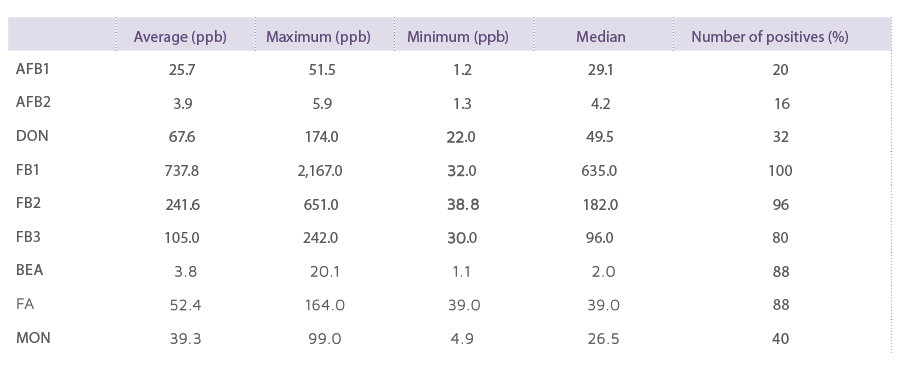
Table 4. Mycotoxin contamination levels (ppb) in corn samples from Brazil in 2024.
COLOMBIA 
The samples received from different regions of Colombia were analyzed for mycotoxins, and all corn samples (100 %) were contaminated with more than 3 types of mycotoxins, demonstrating that the co-occurrence of multiple mycotoxins was the most common trend in these samples.
AFB1 was found in 26 % of the samples, AFB2 in 11 %, while all the samples (100 %) showed the presence of DON (average 412.7 ppb) and FB1 (average 1059.6 ppb). FB2 appeared in 85 % of the samples, FB3 in 81 %, whereas ZEN was found in 44 % of the tested corn samples (Table 5).
All the samples (100 %) showed the presence of BEA, FA, and MON, while 15-ADON was detected in 85 % of the samples.
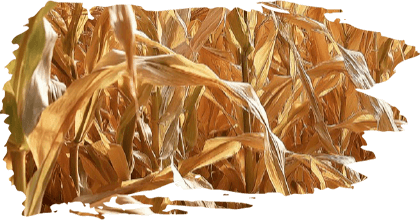
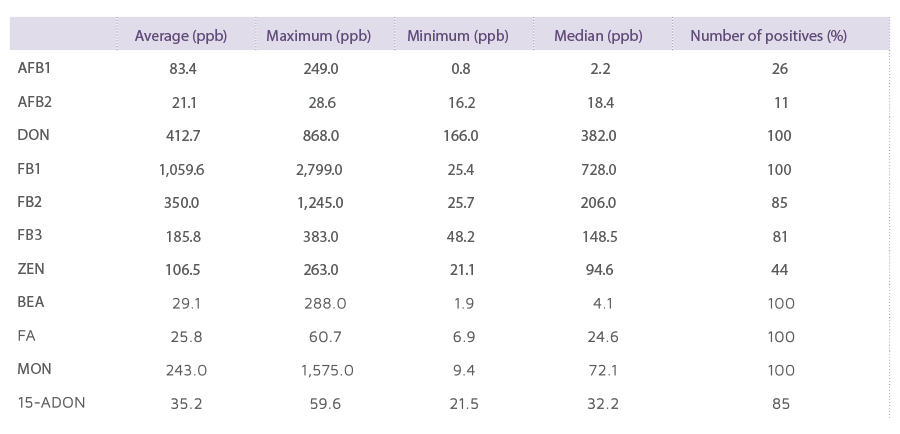
Table 5. Mycotoxin contamination levels (ppb) in corn samples from Colombia in 2024.
COSTA RICA 
Analysis of the corn samples received from Costa Rica using LC-MS/ MS showed that all samples (100 %) contained 3 or more types of mycotoxins, proving co-contamination as a regular occurrence.
The data in Table 6 show that AFB1 was found in 68 % of the samples, AFB2 in 59 %, and AFG1 in 36 %, while DON, with an average of 340.4 ppb, was detected in 77 %. FB1 (average 799.6 ppb) and FB2 were detected in 100 % of the samples, while FB3 and ZEN were detected in 95 % and 59 %, respectively.
ENNB occurred in 18 %, BEA in 82 % of the tested samples, FA in 91 %, and MON was detected in 100 % of the samples.
D-3-G was present in 23 % of the samples, and 15-ADON was detected in 45 % of the samples.
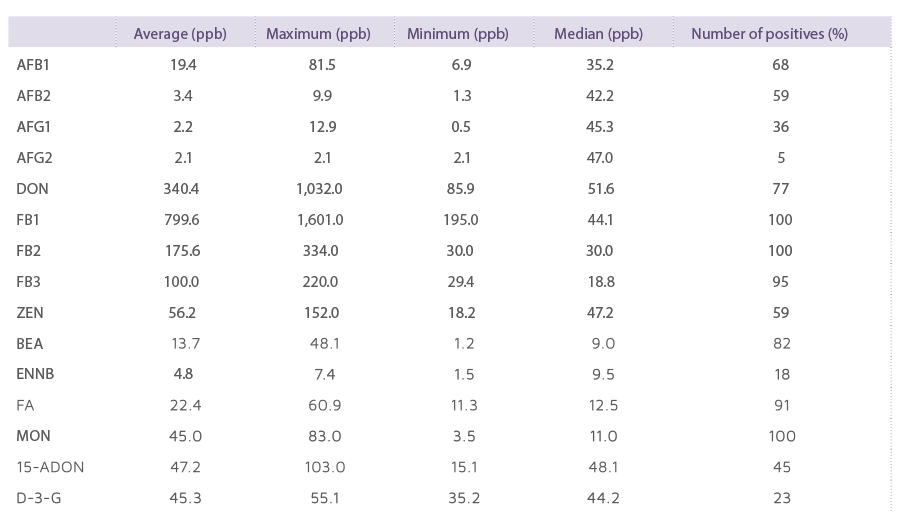
Table 6. Mycotoxin contamination levels (ppb) in corn samples from Costa Rica in 2024.
ECUADOR 
100 % of the samples received from different regions of Ecuador in 2024 were contaminated with more than 3 types of mycotoxins.
AFB1 (average 51.6 ppb) was detected in 95 % of the corn samples (Table 7), AFB2 in 60 %, AFG1 in 48 %, DON in 33 %, and ZEN in 17 %. FB1 (average 1376.7 ppb), FB2, and FB3 were present in all the samples (100 %).
ENNB was detected in 21 % of the samples using LC-MS/ MS-based analysis. FA (average 46.8 ppb) was present in 100 %, whereas MON was found in 74 % of the samples.
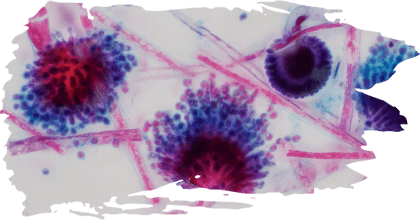
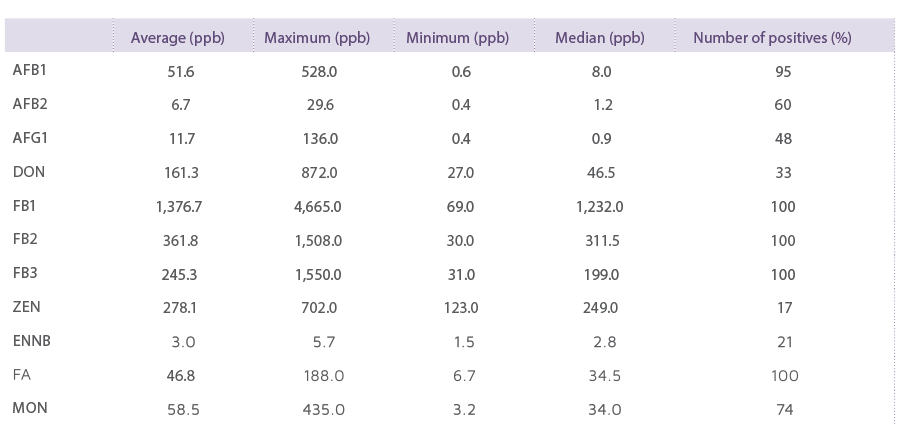
Table 7. Mycotoxin contamination levels (ppb) in corn samples from Ecuador in 2024.
GREECE 
In the 2024 survey of corn samples from Greece, 100 % of the samples were contaminated with more than one type of mycotoxin.
⇰ Among these, 6 % of the samples had 2 mycotoxins, 6 % had 3, and the remaining 88 % had more than 3 mycotoxins (Figure 3).
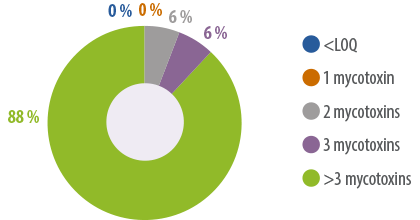
Figure 3. Number of mycotoxins detected in 2024-harvested corn in Greece.
AFB1 was detected in 84 % of the samples, AFB2 in 43 %, and AFG1 in 12 % of the corn samples (Table 8). DON (average 239.9 ppb) was found in 31 %, and FB1, with a high average concentration of 1949.6 ppb, was detected in 100 % of the samples. FB2 was found in 76 %, FB3 in 73 %, and ZEN occurred in 14 % of the samples.
BEA (average 36.5 ppb) and FA (average 67.7 ppb) were present in 80 % of the samples, while MON appeared in 88 %.
15-ADON (average 49.3 ppb) was detected in 10 % of the corn samples.
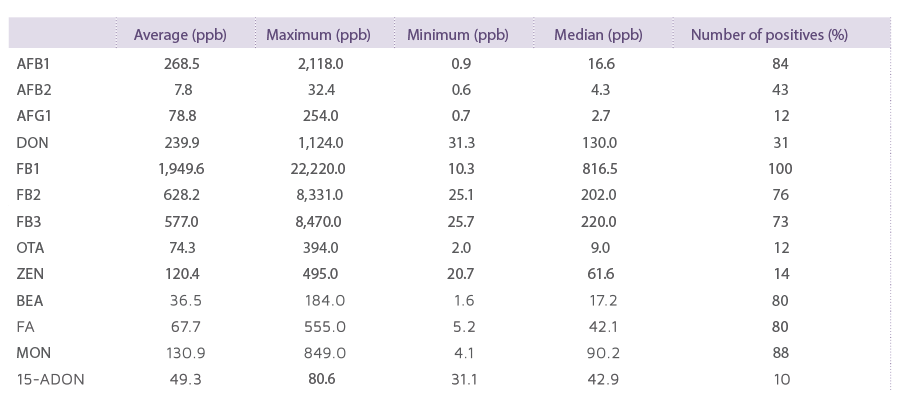
Table 8. Mycotoxin contamination levels (ppb) in corn samples from Greece in 2024.
GUATEMALA 
All the samples of corn (100%) collected in Guatemala in 2024 were contaminated with more than 3 types of mycotoxins.
The data in Table 9 show that DON (average 321.1 ppb), FB1 (average 557.1 ppb), FB2, and FB3 were detected in 100 % of the tested samples.
BEA was detected in 98 % of the samples, ENNB in 94 %, whereas FA (average 98.2 ppb) and MON were detected in 100 %.
15-ADON (average 29.8 ppb) was found in 47 % of the corn samples.
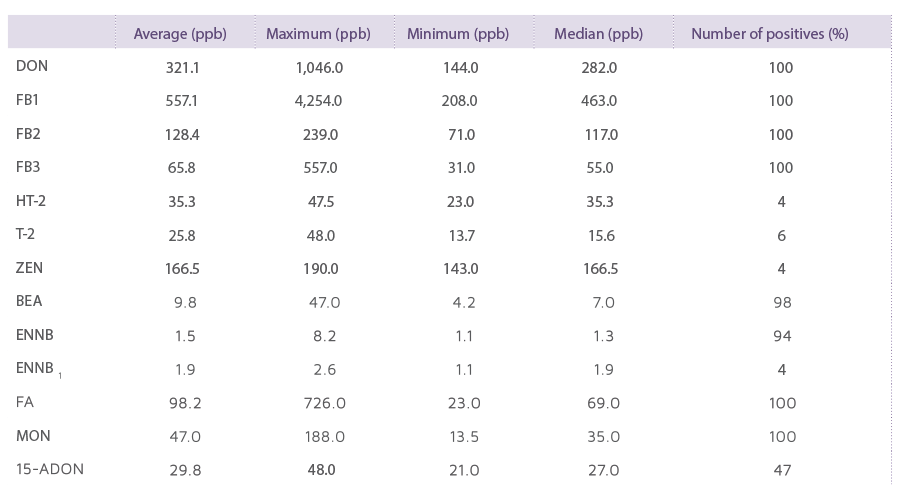
Table 9. Mycotoxin contamination levels (ppb) in corn samples from Guatemala in 2024.
ITALY 
Co-occurrence of more than 3 types of mycotoxins was found in 100% of samples collected in 2024 from different regions of Italy.
AFB1 (average 37.3 ppb) was detected in 75 % of the corn samples (Table 10), AFB2 in 42 %, DON in 25 %, and FB1, with a high average of 2472.6 ppb, was detected in 100 % of the samples. FB2 and FB3 were found in 92 % of the samples, whereas HT-2 and T-2 toxins appeared in 25 % and 17 %, respectively.
BEA (average 190.9 ppb) was detected in 100 %, FA in 75 %, and MON was found in 92 % of the samples.
NEO occurred in only 17 % of the samples.

Table 10. Mycotoxin contamination levels (ppb) in corn samples from Italy in 2024.

MEXICO 
100% of the corn samples from Mexico in 2024 were contaminated with more than 3 types of mycotoxins per sample.
AFB1 occurred in 25 % of the samples, AFB2 in 9 %, and DON, with an average of 498.5 ppb, was detected in 85 % of the corn samples (Table 11). FB1 (average 1177.2 ppb) was detected in 97 % of the samples, FB2 in 90 %, and FB3 in 87 %, whereas ZEN was present in 62 % of the samples.
BEA, FA, and MON were present in 90 %, 87 %, and 97 % of the samples, respectively. 15-ADON appeared in 68 % of the tested samples.
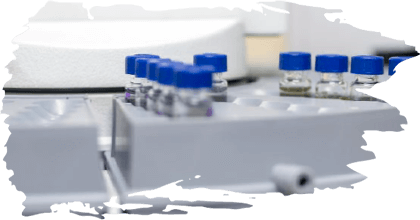
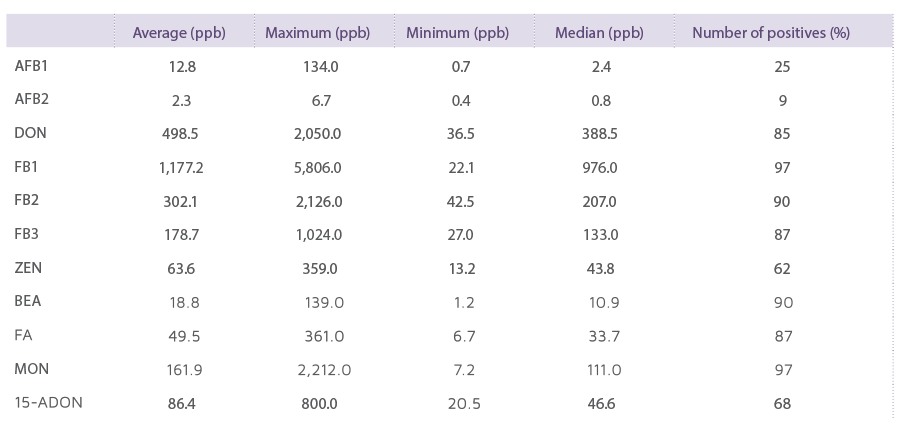
Table 11. Mycotoxin contamination levels (ppb) in corn samples from Mexico in 2024.
PERU 
Corn samples collected in 2024 in Peru were contaminated with more than one type of mycotoxin and almost all the samples were found to contain more than 3 types of mycotoxins.
The data in Table 12 show that AFB1 was found in 44 % of the samples, and DON, with an average of 291.4 ppb, was detected in 94 % of the corn samples. FB1 (average 1650.7 ppb) and FB2 appeared in 100 % of the samples. FB3 was present in 88 %, and ZEN in 44 % of the samples.
BEA was found in 56 %, FA in 94 %, and MON was detected in 63 % of the samples.
15-ADON was also detected in 56 % of the samples.
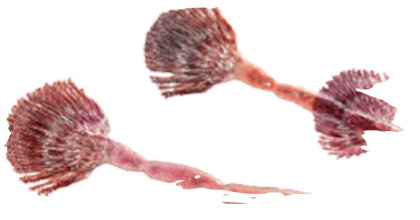

Table 12. Mycotoxin contamination levels (ppb) in corn samples from Peru in 2024.
POLAND 
100 %of the samples obtained from Poland in the 2024 survey were contaminated with more than 3 types of mycotoxins per sample.
AFB1 was detected in 14 % of the samples, AFB2 in 9 %, and DON, with an average of 408.9 ppb, was found in 91 % of the corn samples (Table 13). FB1 (average 675.9 ppb) was found in 77 %, FB2 in 68 %, and FB3 in 59 % of the samples. HT-2 toxin was detected in 14 %, whereas T-2 toxin and ZEN appeared in 23 % and 18 % of the samples, respectively.
BEA was found in 95 %, ENNB in 32 %, ENNB1 in 23 %, FA in 95 %, and MON was detected in 100 % of the samples.
15-ADON was present in 50 % of the tested samples.
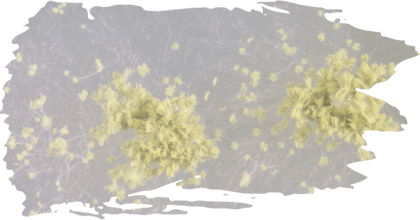

Table 13. Mycotoxin contamination levels (ppb) in corn samples from Poland in 2024.
SERBIA 
In 2024, 93 % of the corn samples harvested from Serbia were contaminated with one or more types of mycotoxins.
⇰ Of these, 16 % of the samples contained 1 mycotoxin, 9 % had 2 types, 11 % had 3, whereas 57 % of the samples had more than 3 mycotoxins per sample (Figure 4).
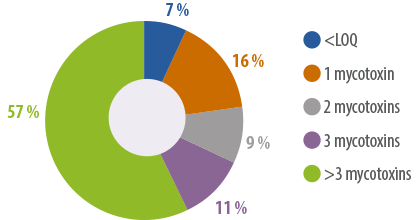
Figure 4. Number of mycotoxins detected in the 2024-harvested corn in Serbia.
AFB1, with a high average of 149 ppb, was detected in 50 % of the samples, AFB2 in 29 %, and FB1 (average 623.6 ppb) was present in 55 % of the samples (Table 14). FB2, FB3, and OTA appeared in 35 %, 33 %, and 6 % of the samples, respectively.
BEA was present in 40 %, FA (average 142.0 ppb) was found in 62 % of the corn samples, and MON was detected in only 35 %.

Table 14. Mycotoxin contamination levels (ppb) in corn samples from Serbia in 2024.
SOUTH AFRICA 
Corn samples collected from South Africa in 2024 revealed that 100 % of the samples were contaminated with mycotoxins.
⇰ Among these samples, 17 % contained 1, 17 % contained 2, 42 % contained 3, whereas 24 % showed the co-occurrence of more than 3 types of mycotoxins (Figure 5).

Figure 5. Number of mycotoxins detected in the 2024-harvested corn in South Africa.
The analysis of samples using LC-MS/MS revealed that DON, with an average of 72.0 ppb, was detected in 58 % of the corn samples, and FB1 and FB2 were detected in 17 % of the samples (Table 15).
BEA was present in 75 %, FA in 92 %, and MON was found in 25 % of the samples.

Table 15. Mycotoxin contamination levels (ppb) in corn samples from South Africa in 2024.
SOUTH KOREA 
Among the samples collected from South Korea in 2024, the majority (100%) were found to contain more than 3 types of mycotoxins.
AFB1 was detected in 6 % of the samples, while DON (average 233.7 ppb) and FB2 were found in 96 % of the corn samples (Table 16). FB1, with an average of 661.3 ppb, was detected in 100 %, and FB3 in 86 %, whereas ZEN appeared in 60 % of the samples.
BEA was found in 92 %, FA in 90 %, and MON was detected in 74 % of the samples.
Among other mycotoxins, only 15-ADON was detected, occurring in 58 % of the samples.
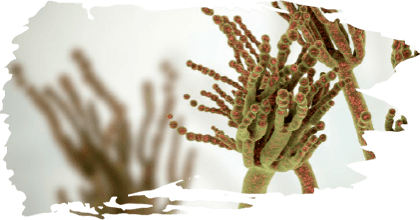
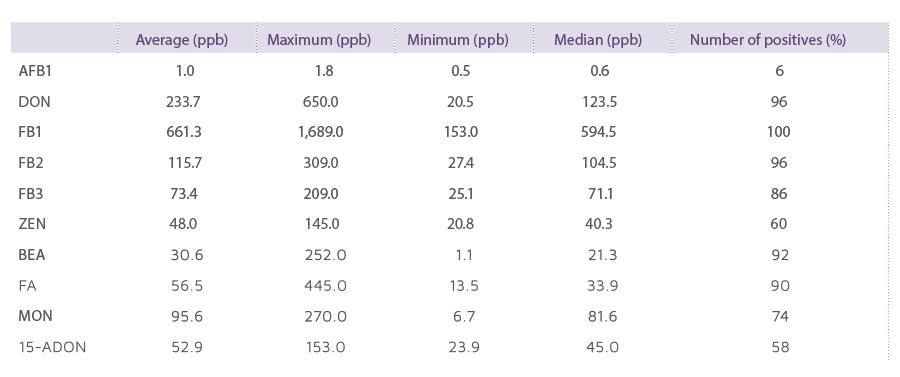
Table 16. Mycotoxin contamination levels (ppb) in corn samples from Korea in 2025.
THAILAND 
All the tested corn samples received from Thailand in 2024 had more than 3 types of mycotoxins per sample.
The analysis of corn samples showed that AFB1 was present in 68 % of the samples, AFB2 in 25 %, and AFG1 was detected in only 7 % of the samples (Table 17). FB1 (average 514.8 ppb) and FB2 were found in 93 %, FB3 in 82 %, whereas ZEN was found in only 21 % of the samples.
BEA was present in 96 %, FA in 93 %, and MON was detected in 29 % of the samples.
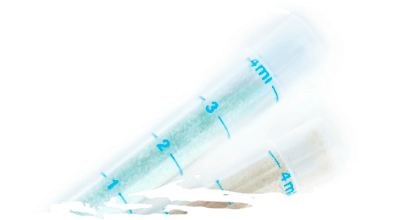
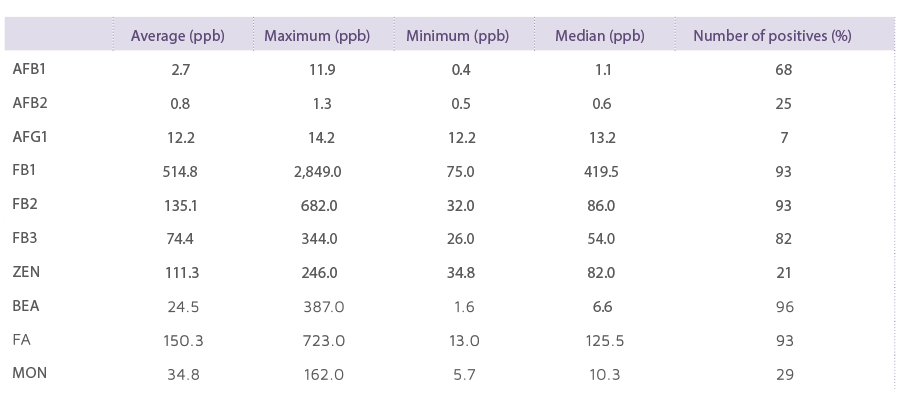
Table 17. Mycotoxin contamination levels (ppb) in corn samples from Thailand 2024.
USA 
Of the corn samples collected in 2024 from the USA, 100 % of the samples had co-occurrence of more than 3 types of mycotoxins per sample.
The analysis of corn samples showed that DON, with an average of 585.1 ppb, was found in 98 % of the samples, and FB1 (average 740.5 ppb) and FB2 appeared in 91 % (Table 18). FB3 occurred in 84 %, HT-2 toxin in 20 %, whereas T-2 toxin and ZEN were detected in 13 % and 22 % of the samples, respectively.
BEA was detected in 87 %, FA in 96 % of the tested samples, MON in 93 %, and 15-ADON was detected in 62 % of the samples.
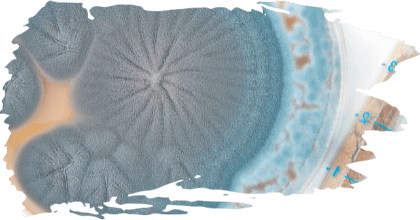
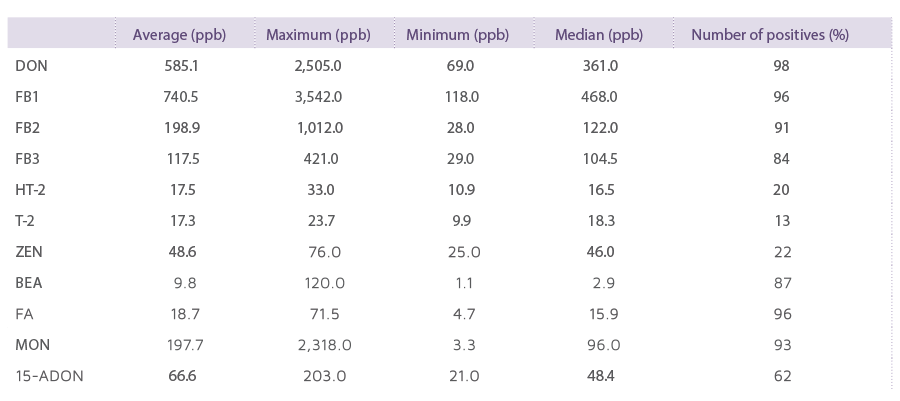
Table 18. Mycotoxin contamination levels (ppb) in corn samples from USA in 2024.
CONCLUSIONS ![]()
In the 2024 corn survey, samples were received from 18 countries worldwide (Algeria, Argentina, Austria, Brazil, Colombia, Costa Rica, Ecuador, Greece, Guatemala, Italy, Mexico, Peru, Poland, Serbia, South Africa, South Korea, Thailand, and the USA) and analyzed for EU-regulated, emerging, and other mycotoxins using LC-MS/MS.
The country-wise mycotoxin results are presented in Table 19.
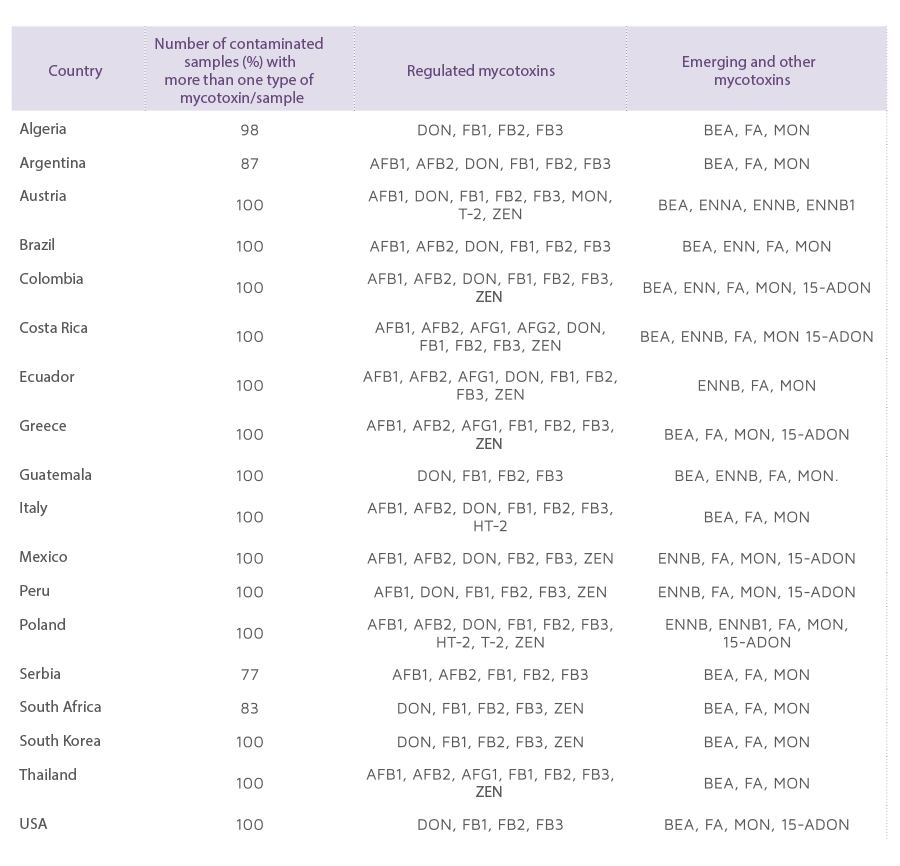
Table 19. Summary of mycotoxin results for 18 countries detected in 2024 harvested corn using LC-MS/MS.
The results (Table 19) showed that 98 % of the corn samples from Algeria, 87 % from Argentina, 77 % from Serbia, 83 % from South Africa, and 100 % of samples from the remaining 15 countries were contaminated with more than one type of mycotoxin.
![]() These co-occurring mycotoxins can have additive or synergistic effects on animals.
These co-occurring mycotoxins can have additive or synergistic effects on animals.
BEA, FA, MON and fumonisins (FB1, FB2, FB3) were the main mycotoxins detected in most corn samples from the 18 countries surveyed.
BEA, FA, MON and fumonisins (FB1, FB2, FB3) were the main mycotoxins detected in most corn samples from the 18 countries surveyed.
This study provides valuable insights into the co-occurrence and co-contamination of aflatoxins, emerging mycotoxins, and Fusarium-produced mycotoxins in most of the 2024 corn harvests from the 18 participating countries.
![]() Aflatoxins —particularly AFB1—posed the most significant threat, frequently exceeding regulatory limits for both human and animal consumption.
Aflatoxins —particularly AFB1—posed the most significant threat, frequently exceeding regulatory limits for both human and animal consumption.
![]() Fumonisins also remained a critical concern, as high levels detected in recent years may be exacerbated by warmer temperatures during the growing season.
Fumonisins also remained a critical concern, as high levels detected in recent years may be exacerbated by warmer temperatures during the growing season.




 Micotoxicosis prevention
Micotoxicosis prevention